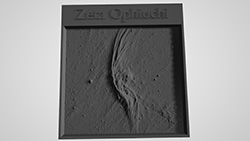CXC Home | Search | Help | Image Use Policy | Latest Images | Privacy | Accessibility | Glossary | Q&A
1
X-ray & Infrared Images of Zeta OphiuchiCredit: X-ray: NASA/CXC/Univ. of Cambridge/J. Sisk-Reynés et al.; Radio: NSF/NRAO/VLA; Optical: PanSTARRS
Zeta Ophiuchi was once in close orbit with another star, before being ejected when this companion was destroyed in a supernova explosion. Infrared data from Spitzer reveal a spectacular shock wave that was formed by matter blowing away from the star's surface and slamming into gas in its path. Data from Chandra show a bubble of X-ray emission located around the star, produced by gas that has been heated by the shock wave to tens of millions of degrees. The Chandra data help tell more of the story of this runaway star.
2
3D Printable Files: Zeta Ophiuchi Tactile Plate (3D Print Credit: NASA/CXC/A. Jubett, using software by Tactile Universe/N. Bonne & C. Krawczyk & Blender)
This tactile plate depicts a star, Zeta Ophiuchi as a physical relief map based on the intensity of the X-ray data captured by Chandra and the infrared data captured by Spitzer. The file for this plate can be downloaded and 3D-printed for learners to touch.
The star Zeta Ophiuchi, which is about 20 times more massive than our Sun, is the main source located at the center of the image. The shockwave appears to the left of the star, with a curve like an archer's bow. Astronomers believe that this shockwave was formed by matter blowing away from Zeta Ophiuchi's surface and slamming into gas in its path, as the star moves from right to left. There are thinner, fainter clouds that streak the entire plate. These faint clouds, felt as thin ridges, represent the gas in the path of the star's shockwave. In the background, small specks, or stars, dot the surrounding space.
The star Zeta Ophiuchi, which is about 20 times more massive than our Sun, is the main source located at the center of the image. The shockwave appears to the left of the star, with a curve like an archer's bow. Astronomers believe that this shockwave was formed by matter blowing away from Zeta Ophiuchi's surface and slamming into gas in its path, as the star moves from right to left. There are thinner, fainter clouds that streak the entire plate. These faint clouds, felt as thin ridges, represent the gas in the path of the star's shockwave. In the background, small specks, or stars, dot the surrounding space.
Return to: Embracing a Rejected Star (July 25, 2022)






